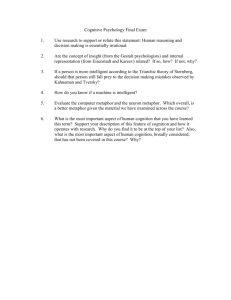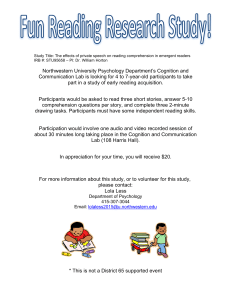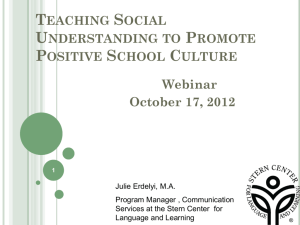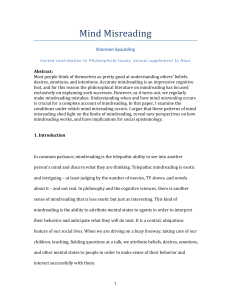PLEASE NOTE this is a sample reading list for the... academic year – precise seminar content may change from
advertisement
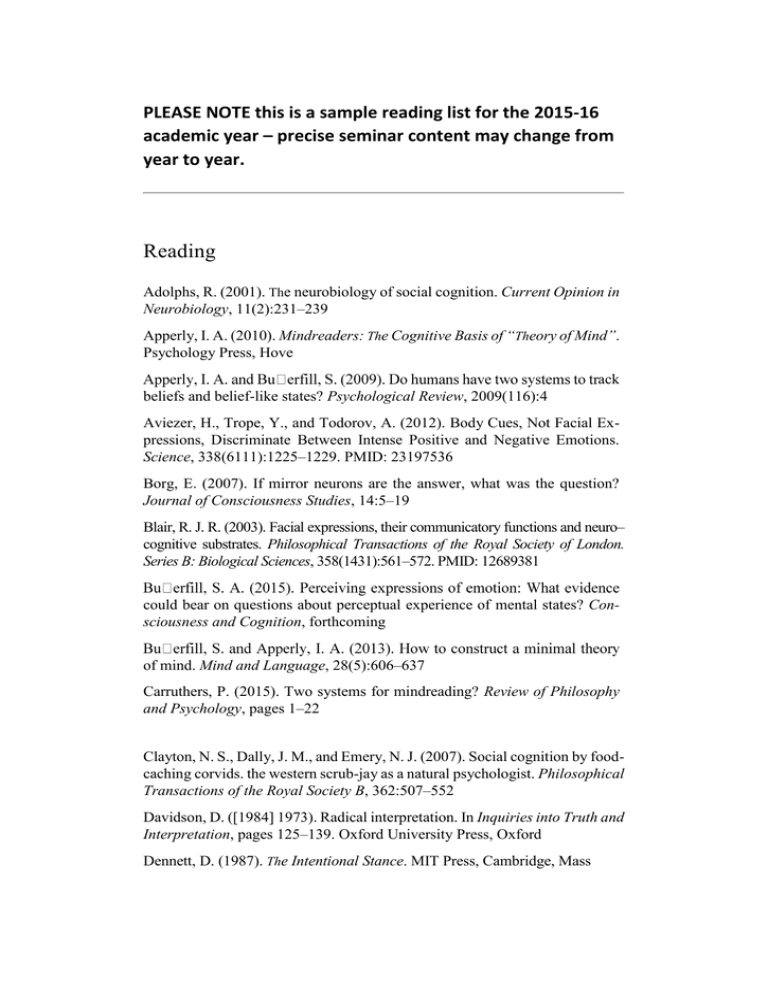
PLEASE NOTE this is a sample reading list for the 2015-16 academic year – precise seminar content may change from year to year. Reading Adolphs, R. (2001). The neurobiology of social cognition. Current Opinion in Neurobiology, 11(2):231–239 Apperly, I. A. (2010). Mindreaders: The Cognitive Basis of “Theory of Mind”. Psychology Press, Hove ack beliefs and belief-like states? Psychological Review, 2009(116):4 Aviezer, H., Trope, Y., and Todorov, A. (2012). Body Cues, Not Facial Expressions, Discriminate Between Intense Positive and Negative Emotions. Science, 338(6111):1225–1229. PMID: 23197536 Borg, E. (2007). If mirror neurons are the answer, what was the question? Journal of Consciousness Studies, 14:5–19 Blair, R. J. R. (2003). Facial expressions, their communicatory functions and neuro– cognitive substrates. Philosophical Transactions of the Royal Society of London. Series B: Biological Sciences, 358(1431):561–572. PMID: 12689381 could bear on questions about perceptual experience of mental states? Consciousness and Cognition, forthcoming of mind. Mind and Language, 28(5):606–637 Carruthers, P. (2015). Two systems for mindreading? Review of Philosophy and Psychology, pages 1–22 Clayton, N. S., Dally, J. M., and Emery, N. J. (2007). Social cognition by foodcaching corvids. the western scrub-jay as a natural psychologist. Philosophical Transactions of the Royal Society B, 362:507–552 Davidson, D. ([1984] 1973). Radical interpretation. In Inquiries into Truth and Interpretation, pages 125–139. Oxford University Press, Oxford Dennett, D. (1987). The Intentional Stance. MIT Press, Cambridge, Mass Gallese, V., Keysers, C., and Rizzolatti, G. (2004). A unifying view of the basis of social cognition. Trends in Cognitive Sciences, 8(9):396–403 Gergely, G., Nadasky, Z., Csibra, G., and Biro, S. (1995). Taking the intentional stance at 12 months of age. Cognition, 56:165–193 Etcoff, N. L. and Magee, J. J. (1992). Categorical perception of facial expressions. Cognition, 44(3):227–40 Heider, F. and Simmel, M. (1944). An experimental study of apparent behaviour. American Journal ofPsychology, 57(2):243–59 Jacob, P. and Jeannerod, M. (2005). The motor theory of social cognition: a critique. Trends in Cognitive Sciences, 9(1):21–25 Liberman, A. M. and Mattingly, I. G. (1985). The motor theory of speech perception revised. Cognition, 21(1):1–36 Low, J. and Watts, J. (2013). Attributing false-beliefs about object identity is a signature blindspot in humans’ efficient mindreading system. Psychological Science, 24(3):305–311 Rizzolatti, G. and Sinigaglia, C. (2008). Mirrors in the Brain: How Our Minds Share Actions, Emotions. Oxford University Press, Oxford Samson, D., Apperly, I. A., Braithwaite, J. J., and Andrews, B. (2010). Seeing it their way: Evidence for rapid and involuntary computation of what other people see. Journal ofExperimental Psychology: Human Perception and Performance, 36(5):1255–1266 Scholl, B. J. and Gao, T. (2013). Perceiving animacy and intentionality: Visual processing or higher-level judgment. In Rutherford, M. D. and Kuhlmeier, V. A., editors, Social Perception: Detection and Interpretation of animacy, agency, and intention, pages 197–230. MIT Press, Cambridge, MA Schneider, D., Slaughter, V. P., and Dux, P. E. (2014). What do we know about implicit false-belief tracking? Psychonomic Bulletin & Review, pages 1–12 Sinigaglia, C. and Butterfill, S. A. (2015). On a puzzle about relations between thought, experience and the motoric. Synthese, pages 1–14 Smith, J. (2010). Seeing other people. Philosophy and Phenomenological Research, 81(3):731–748 Smith, J. (2015). The phenomenology of face-to-face mindreading. Philosophy and Phenomenological Research, 90(2):274–293 van der Wel, R. P., Sebanz, N., and Knoblich, G. (2014). Do people automatically track others’ beliefs? evidence from a continuous measure. Cognition, 130(1):128–133 Wilson, M. and Knoblich, G. (2005). The case for motor involvement in perceiving conspecifics. Psychological Bulletin, 131(3):460–473 Zacks, J. M., Tversky, B., and Iyer, G. (2001). Perceiving, remembering, and communicating structure in events. Journal ofExperimental Psychology: General. Vol. 130(1), 130(1):29–58 Zawidzki, T. W. (2013). Mindshaping. MIT Press, Cambridge, MA

